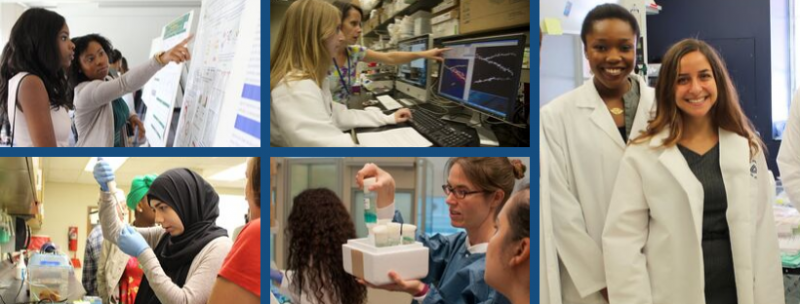Research Shows Us How to Address Underrepresentation of Women in Academic Medicine; Now Let’s Finish the Job
By Dr. Janine A. Clayton
 The engine of the Nation’s biomedical research enterprise is academic medicine—where medical education, medical research, training the next generation of scientists, and clinical care come together. In a similar vein, a 2007 New England Journal of Medicine article went further, calling the research enterprise the “engine of U.S. biomedical discovery.”1
The engine of the Nation’s biomedical research enterprise is academic medicine—where medical education, medical research, training the next generation of scientists, and clinical care come together. In a similar vein, a 2007 New England Journal of Medicine article went further, calling the research enterprise the “engine of U.S. biomedical discovery.”1
The academic medicine talent pool, long recognized as a vital component of that engine, is operating without a full complement of cylinders, creating an untold number of missed opportunities that the Nation cannot afford. What do I mean? Not everyone who is talented and desires a career in biomedical research is included, welcomed, and supported. I’m talking about women—and women of color especially.
Among full-time faculty members at medical schools, women remain underrepresented (39%), with only 4% being women of color.2 And women are half as likely to hold senior leadership positions at medical schools, even when publication productivity is taken into account, according to the results of a 17-year longitudinal cohort study.3 In an Academic Medicine paper published this summer, the authors found gender parity, if not overrepresentation of women, at the instructor level, but “the share of female faculty declines at each subsequent rank, such that the share of female professors is 56% lower than the share of female assistant professors. This decline in female representation is even more pronounced among racial/ethnic minorities.4”
These workforce disparities deny the Nation’s biomedical enterprise the full range of able minds it needs to discover creative solutions to pressing public health problems. It’s time for institutions to step up their efforts to address workforce disparities in academic medicine. Fortunately, we have an evidence base that provides a blueprint for implementing changes in academic medicine.

Calls to enhance America’s leadership and innovative capacity in scientific fields—specifically, science, technology, engineering, mathematics, and medicine (STEMM)—by promoting the participation of underrepresented groups are not new. The 2007 landmark report Beyond Bias and Barriers: Fulfilling the Potential of Women in Academic Science and Engineering recognized the substantial and systemic career impediments that women face and outlined recommendations for change. Soon after, NIH formed the Working Group on Women in Biomedical Careers, which launched the Causal Factors and Interventions research initiative, the largest of its kind ever, to assess institutional barriers to women’s full participation in academic science and engineering. Specifically, it funded 14 grants to identify both the factors that lead to career success for women and interventions that effectively reduce barriers. These grants have been incredibly productive—more than 100 publications strong.5 More specifically, the research systematically documented barriers and best practices in academic medicine. Grantees subsequently formed the grassroots collaborative Research Partnership on Women in Science Careers (Research Partnership) and continue to work for cultural transformation and dissemination of best practices.
A summary of the grantees’ work appears in a 2018 Academic Medicine article by Research Partnership co-authors Phyllis Carr, Anita Raj, Samantha Kaplan, Norma Terrin, Janis Breeze, and Karen Freund.6 Based on extensive interviews at 23 medical schools, the Research Partnership identified numerous barriers to career advancement. Women contend with sexual harassment, negative stereotypes, a disproportionate burden of family responsibilities, inequitable compensation and resource allocation, and implicit bias. These barriers are almost always a part of the academic structure and culture and deeply rooted in institutional norms, so they are not fully recognized, even by those who experience them.
Underpinning the Research Partnership’s work is a keystone concept: Transforming institutional culture, eliminating implicit gender bias, and changing behaviors require awareness, intention, and effort. The authors of this Academic Medicine article present evidence-based best practices that address these barriers:
- To address sexual harassment, implement zero-tolerance sexual harassment policies.
- To reduce negative stereotypes and implicit bias, provide workshops that replace stereotypes with accurate information, offer positive counter-stereotype imaging, and encourage taking the perspective of a stereotyped group.
- To address a lack of access to and support from mentors, facilitate a support network that is diverse in gender, discipline, and rank (including peers) and whose members have participated in formal mentor-training programs.
- To address a disproportionate burden of family responsibilities on women, implement and make faculty aware of standardized policies such as child care leave and “stopping the clock.”
- To address reluctance to take advantage of work–life balance policies and benefits, make benefits opt-out rather than opt-in when possible and ensure that use of leave and part-time status do not affect tenure or promotion decisions.
- To increase representation in leadership roles, provide pathways for women to participate in leadership development and implement sponsorship—in which a senior faculty member becomes an advocate for a talented woman’s career advancement.
Gender diversity has multiple benefits—for women, biomedicine, and society. Research has shown that the collaborative process and innovation can benefit from a diversity of experiences and perspectives. It is now up to the institutions that make up the biomedical research enterprise to implement evidence-based best practices to improve the recruitment, retention, and advancement of women in biomedical careers. Many already are, but not enough. Because of the Research Partnership on Women in Science Careers, we now know how. So let’s all make it happen.
1 Heinig, S. J., Krakower, J. Y., Dickler, H. B., & Korn, D. (2007). Sustaining the Engine of U.S. Biomedical Discovery. The New England Journal of Medicine, 357, 1042–1047. doi:10.1056/NEJMsb071774
2 Lautenberger, D., Moses, A., & Castillo-Page, L. C. (2016). An Overview of Women Full-time Medical School Faculty of Color. Analysis in Brief, 16(4), 1–2.
3 Carr, P. L., Raj, A., Kaplan, S. E., Terrin, N., Breeze, J. L., & Freund, K. M. (2018). Gender Differences in Academic Medicine: Retention, Rank, and Leadership Comparisons from the National Faculty Survey. Academic Medicine, 93(11), 1694–1699. doi:10.1097/ACM.0000000000002146
4 Raj, A., Kumra, T., Darmstadt, G., & Freund, K. (2019). Achieving Gender and Social Equality: More Than Gender Parity is Needed. Academic Medicine. Published ahead of print. doi:10.1097/ACM.0000000000002877
5 For a comprehensive review of NIH efforts to promote women in biomedical careers, see Plank-Bazinet et al. 2016. Programmatic efforts at NIH to promote and support the careers of women in biomed. sci. Academic Medicine 91(8): 1057–1064.
6 Carr, P. L., Raj, A., Kaplan, S. E., Terrin, N., Breeze, J. L., & Freund, K. M. (2018). Gender Differences in Academic Medicine: Retention, Rank, and Leadership Comparisons from the National Faculty Survey. Academic Medicine, 93(11), 1694–1699. doi:10.1097/ACM.0000000000002146
